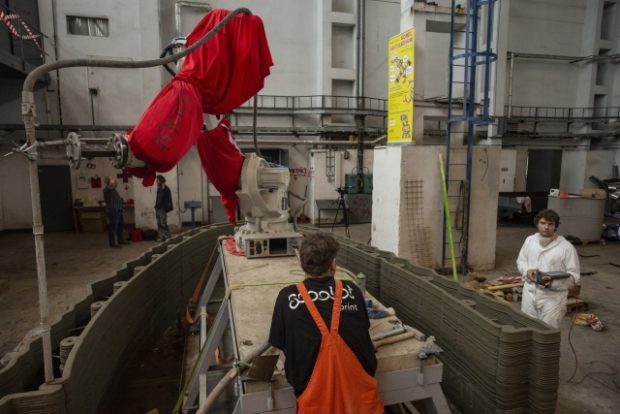Czech sculptor creates 3D-printed floating house

Workers check the 3D printing of the first-ever concrete house in Czech Republic on June 15, 2020, in Ceske Budejovice city. Image: AFP/Michal Cizek
A Czech sculptor has teamed up with a group of architects to create a 3D-printed house prototype that could become a holiday home for the future.
The house is being printed from special concrete in the southern Czech city of Ceske Budejovice and is planned to float on the Vltava river in Prague in August.
“I dare say it’s the first-ever floating 3D-printed building in the world,” sculptor Michal Trpak, the mastermind behind the project, told Agence France-Presse.
The design of the house, which can be printed in two days, was inspired by a single-celled creature known as a protozoa, he says.
As an added attraction, Trpak plans to turn the abode into a floating garden, with plants covering its roof and outside walls.
The simple 43-square meter (51.4 square yards) floor plan includes a living room with a kitchen, a bedroom and a bathroom.
“3D houses will adapt to the people or the countryside. The robot doesn’t care about the shape of the curve,” Trpak said to the hum of a mechanic hand with a nozzle patiently piling up layer after layer of concrete strips.
“The house is intended as a leisure-time house to stand in the countryside, ideally for a couple or a small family,” added Trpak, who drew inspiration from 3D-printed housing projects in the Netherlands.
‘Trial and error’
To finance the project, dubbed the “Protozoan,” its creators have teamed up with a Czech building society.
“This one is pretty expensive because it’s a prototype and we needed many tests…. But the second generation should cost around 3 million Czech crowns (112,600 euros; $127,500) and the third generation may cost about half of that amount,” Trpak said.
When the robot is done, the concrete bedroom and bathroom modules will be attached to a wooden core with large windows and completed with a wooden roof.
The house will then be transported to Prague, installed on a pontoon and displayed on the Vltava river in Prague’s broader center for two months.
“We didn’t have a plot of land to place it on, and anyway, to do that, you need a building permit and that takes up to two years” to secure, said Trpak. “But if you float it on a river, you only need consent from the navigation body, which is much faster.”
Trpak said the construction had not been trouble-free as the concrete is sensitive to temperature changes.
“When it’s very warm it hardens faster, when it’s cold it hardens more slowly so now we’re adding warm water from a boiler,” he added as the weather changed for the worse. “We keep researching and developing. It’s a process of trial and error.” RGA
RELATED STORIES:
WATCH: Mink, the 3D printer that lets you print makeup at home
Teacher makes over 4,000 face shields for COVID-19 frontliners